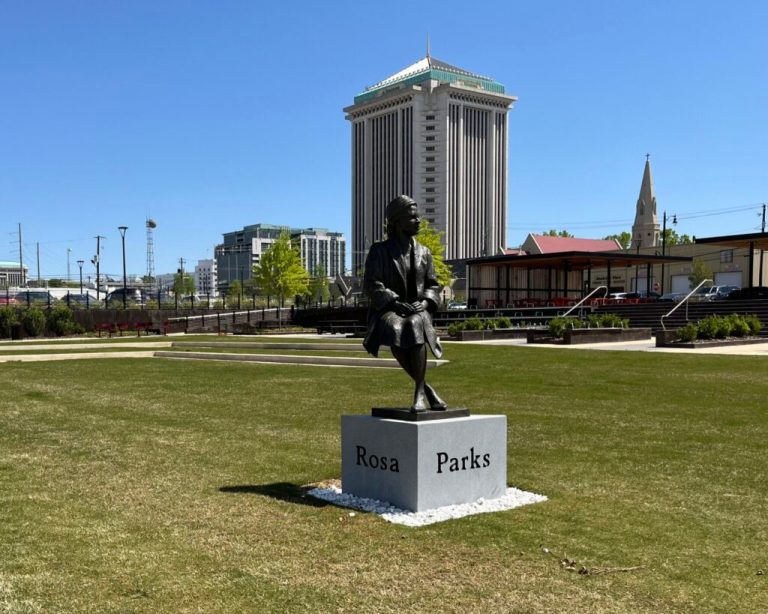Reviewed by: Pat Byington
EJI unveils new National Monument to Freedom to honor memory, legacy of enslaved people
Reading time: 6 minutes

It’s never easy to take a trip through the history of slavery in the U.S. but many monuments and memorials across the country are vital in teaching newer generations about that history. The latest experience has officially opened in Montgomery as a part of the Equal Justice Initiative’s Legacy Sites.
We took a trip to Montgomery, stopping at some of the Legacy Sites along the way before walking through the Freedom Monument Sculpture Park which proved to be an emotional, educational and important trip to take.
Here’s what we saw, what we learned and what to expect if you want to plan a trip to the sites in Montgomery.
Freedom Monument Sculpture Park
Wednesday was a busier day around the Legacy Sites with plenty of people packing the museum, memorials, and shuttle buses before walking through the park on its opening day. While in Montgomery, I saw two family reunion groups, an HBCU tour group, a high school field trip, multiple international families and cars with tags from Arizona, Maryland, Florida, Texas and Washington.


When leaving the museum, you are given an option of taking a bus directly to the park or a bus to a dock on the Alabama River to take a boat ride to the park. If you choose the boat, you are taken to the Riverfront and dropped off near the historic marker where enslaved people were transported to Montgomery by boat and train before being paraded through the streets to be sold.
That’s the thought that sticks with you the most while you wait on the pontoon boats, Legacy I or Legacy II, which will take you down the Alabama River to the park.
“While this quest is not over, Freedom Monument Sculpture Park stands in tribute to all those who acknowledge the legacy of slavery in America, the racial inequality it created, and the continuing struggle to achieve freedom and justice for all.”
~ A plaque near the entrance of Freedom Monument Sculpture Park
After getting off the boat, you will go through security, who will continuously remind you no videos are allowed in the park and photos are only allowed in two spots. You move through the opening in the outer gate before being brought to the entrance of the park where the first sculpture immediately grabs your attention.

There were several sections of the park dedicated to different parts of the country’s history of slavery, starting with a section dedicated to indigenous people and the land + freedom that was taken from them by colonizers. Other sections included:
- Abduction, kidnapping and trafficking of African people
- Slavery laws in the U.S. stating how slave owners were allowed to treat people
- Dwellings of enslaved people
- Wall of over 100 bronze masks honoring the nearly 6 million people who died while enslaved
Of course, some of the biggest and most memorable spots at the park were the pieces of art and sculptures along the walk to the National Monument to Freedom. Here are just a few that stood out:
- Brick House bronze sculpture at the entrance
- Three Sisters granite sculpture
- We Am Very Cold bronze sculpture
- Free At Last steel sculpture
National Monument to Freedom
Near the end of the walk through the part, you start to see the large monument wall towering above the other sculptures. After the wall of masks, you enter into the most open space of the entire park.

The monument is a large wall that has more than 100,000 unique surnames that were chosen by more than 4 million formerly enslaved people during the 1870 census. After the Civil War ended, it was the first chance for many of those formerly enslaved people to choose their own names.
While at the monument, you can scan a QR code and search any name to find if it is on the wall and where to find it. There were also workers on site to help people find names.
The Legacy Sites
EJI has committed plenty of time, effort and funding to create these sites to not only honor the lives of people who were enslaved in the country but also to educate people on historic events that took place in this country over the last two centuries.
“Situated on lands occupied by Indigenous people for centuries, in a region that once held the largest population of enslaved Black people and would later become the heart of the Civil Rights movement, the Legacy Sites offer visitors a powerful opportunity to engage with history and begin an era of truth telling.”
~ Equal Justice Initiative
Here are the stops we made in the trip through Montgomery:
- National Memorial for Peace and Justice
- Legacy Plaza
- Legacy Museum/Memorial
- The new Freedom Monument Sculpture Park



You just need to buy one $5 ticket with an option to donate more to get access to all the sites. All of the sites are within two miles of each other and shuttles run between each location for those who do not want to walk.
The national memorial is an outdoor exhibit that is dedicated to those killed in racial lynchings. It uses sculptures and art to honor those people and remember the racial terror + its impact on the country still today.
EJI recommends people spend 3-5 hours in the Legacy Museum. No photos or videos are allowed in the museum and people are encourage to turn their phones completely off while moving through the museum.
Just outside the museum is a small memorial which is dedicated to thee memory of thousands of unnamed people who who were killed in lynchings in the 12 years following the Civil War. You can take time at the memorial before boarding the shuttle to the new park.

Will you be heading to Montgomery to visit any of the Legacy Sites from EJI? Share it with us on The Bama Buzz Facebook, LinkedIn, Twitter, + Instagram.



